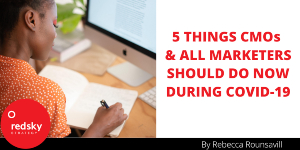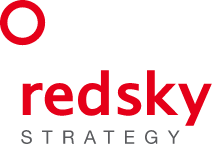News
5 Things that CMOs and All Marketing Professionals Should Do Now During COVID-19

By Rebecca Rounsavill, Managing Director
COVID-19 brought with it not just a virus, but a whole change to our ecosystem. In the first few weeks, consumers were still in shock, figuring out the basics like how to safely go to the grocery store, how to do their work online, and how to stay connected to co-workers, friends and loved ones. But now, the original shock is transitioning into a new normalcy, and buying behavior is starting to reflect that with purchases shifting from toilet paper and canned goods to items like clothing (mostly tops), hair color, and trimmers.
Yet, we know that more change is coming. Eventually, the quarantine will end, children will go back to school, people will go back to work, and restaurants will reopen. But things will never go back to the way they were — at least not completely. So how do you lead your organization through all of this change and keep your brands relevant?
The following is our approach to managing change:
-
Maintain a strong team.
The first step in achieving a strong post-COVID-19 organization is to nourish a team of happy, engaged and productive human beings. This can be challenging with the stress of the pandemic hovering in the background. Many people are suffering physically, financially and emotionally. If you expect your employees to care for your customers, you need to show that you care for them, too. So how can you ensure that employees working from home still feels connected to the business and to each other? How can you ensure that your essential employees who are still going into work feel safe? How can your teams still collaborate effectively?
Some things you can do to help:
-
- Make sure everyone is equipped with what they need to be successful. Assign a productivity agent to identify any barriers and support efforts to make sure business and even personal needs are met. Whether you are upgrading video conferencing systems, computers, and WiFi, or providing homeschooling tutors and protective gear, these efforts will enable your team to work harder and feel more engaged.
- Create new Ways of Working (WOWs) for your teams who are now working online. Ask employees to use video where possible to stay more connected. Develop a process for more cohesive hand-offs. Create shared folders and documents for team collaboration. Consider using online chat rooms like Slack to encourage small talk and make information exchanges easier.
- Encourage online learning. Our research shows that 34% of people are spending their time alone. Give employees who are stuck at home new opportunities to upgrade their skill sets. Identify skills and corresponding classes that will help to achieve the organization’s long-term goals.
- Over-communicate. Utilize multiple formats in multiple time slots to ensure that teams are aligned and moving in the same direction.
-
Re-think your business model.
Make changes now to ensure that your organization will be viable long term. Refocus your people, resources and spending on those areas most likely to thrive during the pandemic, and post-pandemic (given the associated recession). The organizations who are best at hypothesizing what the new normal will look like and then making the necessary changes to capitalize on it are the ones who are going to win. After all, the way your audience is making purchase decisions is being affected by several different dynamics. You will need to adapt your organization to manage these changes, some of which our society has experienced before, and others not, like:
- Pandemic fear-driven purchasing
- Convenience and safety
- Economic downturn conservatism
- Comfort purchases
- New necessities (e.g., sweatpants, recipes)
Build a model to help re-evaluate brands, markets and channels in a consistent way. Choose factors that are relevant to your industry, like price elasticity, adaptability to eCommerce, consumed in-home, etc., to assess potential. Be very clear on your choices about where to focus and where not to focus. Then, make changes to align to the new strategy. Actioning these changes is key to success.
-
Reconsider your target.
Are you focusing on the right target to weather a pandemic and recession? Is your segmentation still relevant? Is there a subset of your target that is now more appropriate for your brand? For some categories, users may have changed significantly. For example, 33% say they are now buying more vitamins than before COVID-19. A shift like this could have a big impact on audience selection. Some examples of potential target changes include:
-
- The new financial situation: As of mid-April, 22M people were unemployed. Some estimate that the unemployment rate could reach 30%. These people’s needs differ greatly from when they were employed.
- Parents who are homeschooling: There is a high level of stress among those now trying to work, cook, and homeschool their children all at the same time. If you are targeting moms, how does this factor into your strategies? How are you supporting them?
- Essential employees: A large group of the population cannot practice social distancing due to their work, and there is a heightened need for health and safety among this group. This could be a potential area of opportunity for healthcare companies.
-
Focus on trust in your current engagements with customers and consumers.
BrandTrust is critical in times of uncertainty. Consumers are judging brands on how well they respond to the current COVID-19 crisis. So you need to be empathetic and socially responsible, but specific and authentic to your brand. While your product probably can’t address everyone’s overarching anxieties or concerns, there is likely a way to bring positive change that makes sense for you. For example, Crocs is donating a free pair of shoes (with free shipping) to healthcare workers on the frontlines of COVID-19. Their message clearly reflects their brand benefit while still being relevant to the pandemic. “If you’re a healthcare professional in need of our easy-to-clean, comfortable Crocs shoes, we’ve got you taken care of.” Some must do actions:
- Re-evaluate all audience communications to ensure they are still relevant. You do not want to appear tone deaf in the current environment. (For example, Anthropologie keeps sending me emails featuring clothing more appropriate for the office or an evening out. All I really want are sweatpants and some cute items for my kitchen. Needless to say, I opted out of future emails.)
- Consider social responsibility and how your brand can uniquely help the audience you serve deal with the pandemic, and society as a whole. Take a stand if it will help you maintain your target’s trust – but don’t do it to be self-serving (e.g., IKEA’s “stay home” ad provided useful tips on home projects that could be done while practicing social distancing, while McDonald’s logo change for social distancing felt more like a grab for attention.)
- Show the value your brand can provide in today’s world. As the need for your services or offerings arises, present the benefit in more value-driven, utilitarian ways that reflect the current climate. In late March, Little Caesar’s began airing a new spotthat emphasizes how its pizzas are cooked in a 475-degree oven, and are not touched once they are baked.
- Understand your audience’s tone and be extra empathetic in your response, not only because you see what people (consumers) are needing, but because we’re all in need of more kindness. More generosity. More human.
-
Update future brand strategies and marketing plans
to be more prepared for the state of the economy, and consumer mindsets post-pandemic.
-
- Re-evaluate your target insight and brand positioning. Every brand will need to look at their consumers with a new lens, and uncover the insights and motivations driving them in this new world. Proprietary research at RedSky shows that women are feeling anxious, scared and sad, while men are also feeling anxious, but are feeling more calm and hopeful. This could have an impact on how they will relate to your brand.
- Update marketing plans to include new ways of reaching your target, and potentially, new channels of distribution. Consider the emotions and experiences your audiences will be craving once this is all wrapped up. How can your brand uniquely deliver on these needs? Behr was one of the first brands to offer Zoom conference call background pictures. It helped enable them to stay top of mind as consumers undertake home innovation projects while nesting.
- Engage in scenario planning. Identify the most likely range of scenarios and plan for them. This will help increase agility with the predicted market fluctuations.
- Realign your new product pipeline with your target’s changing needs. Think about the economic downturn, the heightened need for safety, and the ongoing desire for comfort. How can you drive innovation to fulfill those needs?
At RedSky, we genuinely care about how you are coping. We have been working hard to keep our entire staff engaged and productive throughout this crisis to-date, and have been doing independent research to better understand the new world we are facing. Good luck — and let us know if we can help.
